Jump to:
Lack of sunlight and watering are often the main causes of plant death, but a virus can have the same negative impact. The problem is that by the time you notice it, it might already be too late to stop.
Understanding the symptoms and severity can help you stop them before they spread and the consequences get worse. That’s what this guide is for. It explains what a plant virus is, the common ones most gardeners encounter, and how to control them.
Plant Viruses Explained
Plant viruses are quintessential parasites that can’t reproduce on their own. Instead, they infect a plant and use their cells to multiply. However, due to the tough outer wall of plant cells, these viruses struggle to move between them. Because of this, they spread in two main ways:
- Horizontal transmission: From outside sources, like when insects or infected seeds carry the virus from one plant to another.
- Vertical transmission: Passing from a parent plant to its offspring through infected seeds.
Simply put, horizontal spread happens between different plants, while vertical spread passes down to the next generation.
Signs of Plant Viruses Affecting Your Plants
Changes in leaf colour and morphology (or shape) are common symptoms when a plant is infected with a virus.
Changes in leaf colour include mottling, mosaic, vein clearing, and leaf spots. Mottling appears as irregular spots or blotches, either yellow or green, on leaves. The same goes for mosaic viruses, causing patchy appearances of light and dark green.
Vein clearing is when the veins of a leaf turn pale or translucent instead of their normal green colour. Leaf spots are discoloured areas on leaves, ranging from yellow, brown, or black.
Changes in leaf morphology involve rolling, curling, distortion, puckering, and enation. Rolling is when leaves begin to roll inward or outward, while curling happens when they twist or curl at the edges.
Distortion leads to abnormal leaf shape and growth, puckering creates wrinkles, and enation appears as a small, wart-like form on the leaf surface.
Other signs include stunting, where a plant is reduced in size or ‘dwarfed’, and stem pitting, which causes small dents or sunken areas to form on the stem.
Common Plant Viruses You Need to Look Out For
These plant viruses exhibit most of the symptoms mentioned above in the plants they infect:
Cucumber Mosaic Virus (CMV)
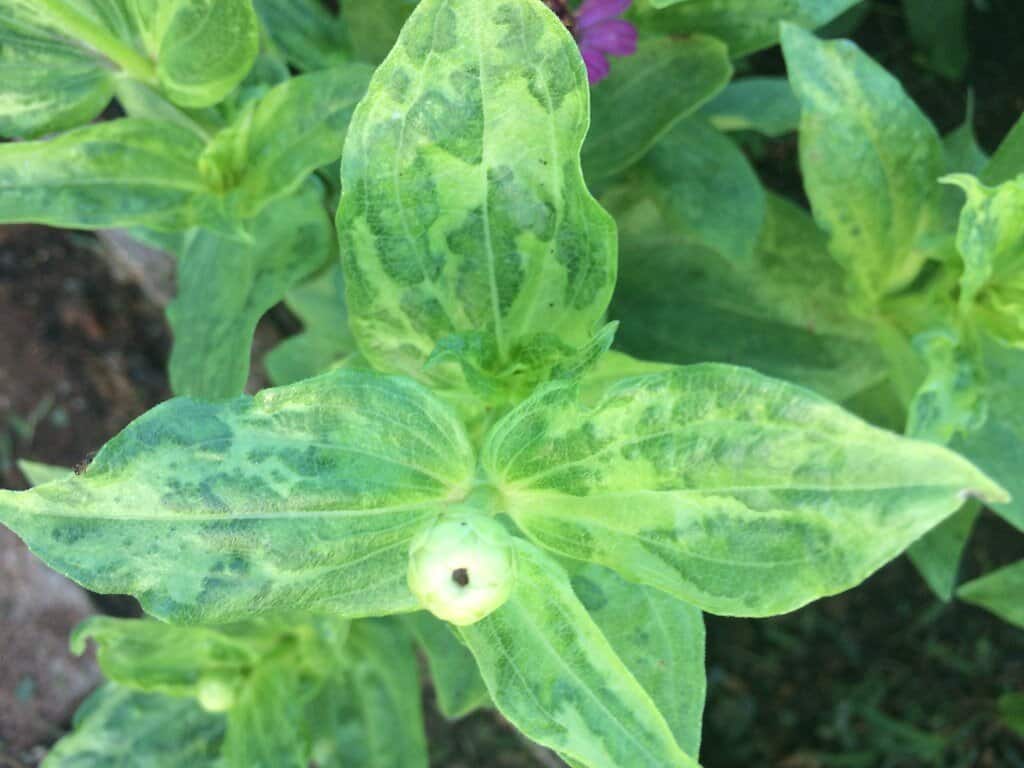
CMV is a plant pathogenic virus known for its wide host range and is transmitted by aphids. It causes mosaic patterns, stunted growth, and yellowing in vegetables like cucumbers, tomatoes, and peppers.
Tomato Mosaic Virus (ToMV)
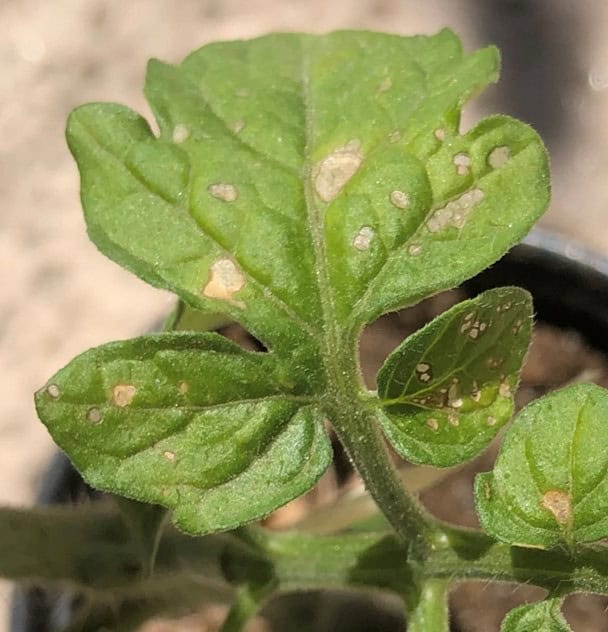
(Image Credit: Wikimedia Commons)
ToMV is a specific strain of TMV that infects tomato plants. It leads to yellow mosaic symptoms on the leaves and tomato fruits, with signs appearing as mottling or a mosaic pattern on the foliage.
Potato Virus Y (PVY)
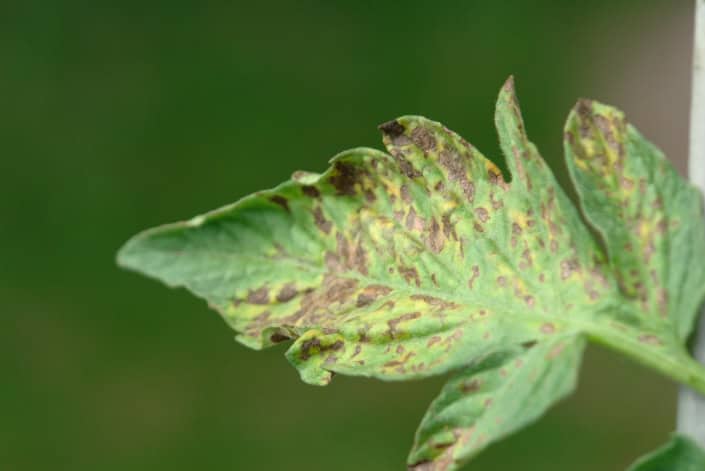
PVY is a common virus that affects potato production, primarily spread by aphids and other species that migrate through the crop. When an aphid feeds on a PVY-infected potato, it picks up the virus within 1–2 seconds of feeding. The infection results in mottling, leaf drop, stunting, and necrotic rings on the skin of tubers.
Zucchini Yellow Mosaic Virus (ZYMV)
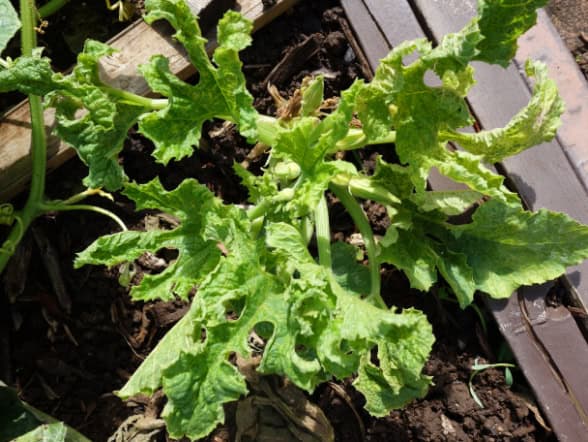
ZYMV is a virus spread by aphids that affects zucchini and other cucurbits. It reduces crop yield and lowers fruit quality, causing yellowing and mosaic patterns on the leaves.
Tomato Spotted Wilt Virus (TSWV)
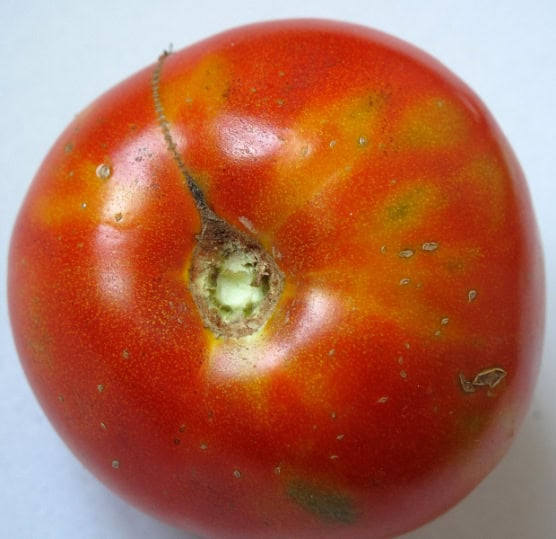
(Image Credit: Wikimedia Commons)
TSWV is a virus spread by insects like thrips. Signs of infection in tomatoes include general yellowing or bronzing of leaves, along with a distinctive pattern of concentric rings or spots. It also affects lettuce and peppers.
Unfortunately, infected plants can’t be cured and should be removed to prevent the virus from spreading to healthy ones.
Pepino Mosaic Virus (PepMV)
PepMV can infect aubergines (eggplants), along with other crops like tomatoes and potatoes. It causes symptoms such as patchy discolouration, abnormal leaf growth, and dwarfing. Brown or necrotic areas may also develop inside the fruit, preventing proper ripening.
Cucumber Green Mottle Mosaic Virus (CGMMV)
CGMMV spreads through infected seeds, contaminated surfaces, and plant-to-plant contact. It attacks plants within the Cucurbitaceae family, including cucumber, watermelon, pumpkin, and squash. It can also infect non-curbit weeds, like black nightshade.
How to Control Plant Viruses in Your Garden or Greenhouse
The best way to manage plant viruses is before planting the crop. Unlike fungi and bacteria, there are no chemicals that can completely kill viruses or protect plants from infection. Once a plant is infected, it remains infected.
Protect new plants from infection
If the plant is one of those affected by the viruses mentioned above, take the necessary precautions. Remove or avoid anything that could carry a virus. This includes getting rid of infected plants (if there are any from your old ones), as you already know by now that they can spread the virus to healthy ones.
You’ll also want to make sure the beds are free of weeds or plant debris from the previous harvest to give your new plants a clean and healthy spot to grow.
Keep an eye out for small, leaf-like crawlies like aphids, especially if you’ve had issues with them before. For extra protection, cover young plants with fine mesh or row covers to keep them at bay.
Companion plants to repel virus-carrying pests
Aphids are one of the biggest troublemakers when it comes to spreading plant viruses. A simple way to keep them away is by planting a few good companions around your veg. Marigolds, garlic, and chives are great options, as they naturally repel aphids.
Companion planting works by throwing pests off. Marigolds, for instance, have a scent that aphids can’t stand, and garlic and chives have strong-smelling compounds that help keep them away. They won’t get rid of aphids completely, but they can lower the risk of an infestation.
To make the most of this, mix these companion plants in with your vegetables rather than keeping them separate. Give them enough space so air can circulate—this also helps slow the spread of viruses if they appear. And don’t forget to rotate your crops each year to stop pests and diseases from building up in the soil.
Clean your garden tools
Pathogens can linger on tools, and if they’re left unclean after use, they can harbour not just viruses but also bacteria and fungi. If you overlook this, your tools could end up spreading disease to your plants without you even realising.
Your efforts in keeping pests away and maintaining a clean plot will be wasted. A quick rinse isn’t always enough, either. Here’s how to clean garden tools the right way:
- Give your tools a good wash with soapy water to get rid of any grease and grime.
- If there’s stubborn dirt stuck on, grab a stiff brush and scrub it off—especially on rough surfaces where muck likes to cling.
- Rinse everything off with clean water. A hard spray or even a pressure washer can help blast away any caked-on dirt, especially in those awkward spots like between the tines of a tiller.
Some tools may need disassembling for proper cleaning. Refer to their manual if possible. These steps also work for planters, except for wooden ones.
Wooden planters naturally repel bacteria and fungi, but they still can get dirty. To clean, wash them with warm, soapy water, let it dry, and oil or wipe with a wood preservative afterwards.
Take advantage of garden storage

Now, you may be wondering how this can help with prevention.
Let’s start with a shed—a home for your garden tools, keeping them in one place and away from potential sources of infection. If possible, use it just for equipment, so you’re not bringing in soil or plant debris that could carry lingering pathogens.
Something like the BillyOh Master Tall Store works well for this, especially with its built-in shelving to help you keep things organised.
If your garden space allows it, you may want to consider something bigger than a shed storage, like a potting shed. Inside is a space designed for repotting, seed-starting, and general plant care, usually with a potting bench and enough room to work comfortably. There can also be storage for tools, pots, and compost, often tucked beneath the shelves, in the corner, or on the opposite side.
A dedicated place for potting gives you a controlled environment where you can tend to seeds, cuttings, and young plants without exposing them to outdoor contaminants. An enclosed space can keep virus-carrying insects at bay, too.
Here’s a guide on ‘Why A Potting Shed Could Be Perfect For You’ to learn more.
Tips: Keep the air flowing, especially in the potting shed. Without good ventilation, moisture builds up, making it a breeding ground for mould, fungi, and plant diseases. Also, stay on top of tidying! Sweep up any soil spills, clear out dead leaves, and give surfaces a regular wipe-down to keep things clean.
Round-up
CMV, ToMV, PVY, ZYMV, TSWV, PepMV, and CGMMV are among the common plant viruses found in most UK gardens. Symptoms include mottling, mosaic, vein clearing, and leaf spots, as well as rolling, curling, distortion, puckering, and enation.
To prevent these plant viruses, you need to act before you even start planting. Remove any infected plants to stop the spread, and keep an eye on weeds and aphids. For extra protection, you can cover your plants with fine mesh or row covers.
Companion planting is also worth considering, with marigolds, garlic, and chives being great options. Cleaning your garden tools regularly is another good habit, and that’s where your shed or potting shed comes in. By using it to store your tools, seedlings, plants, and other gardening essentials, you can keep everything clean and organised, reducing the risk of contamination.





